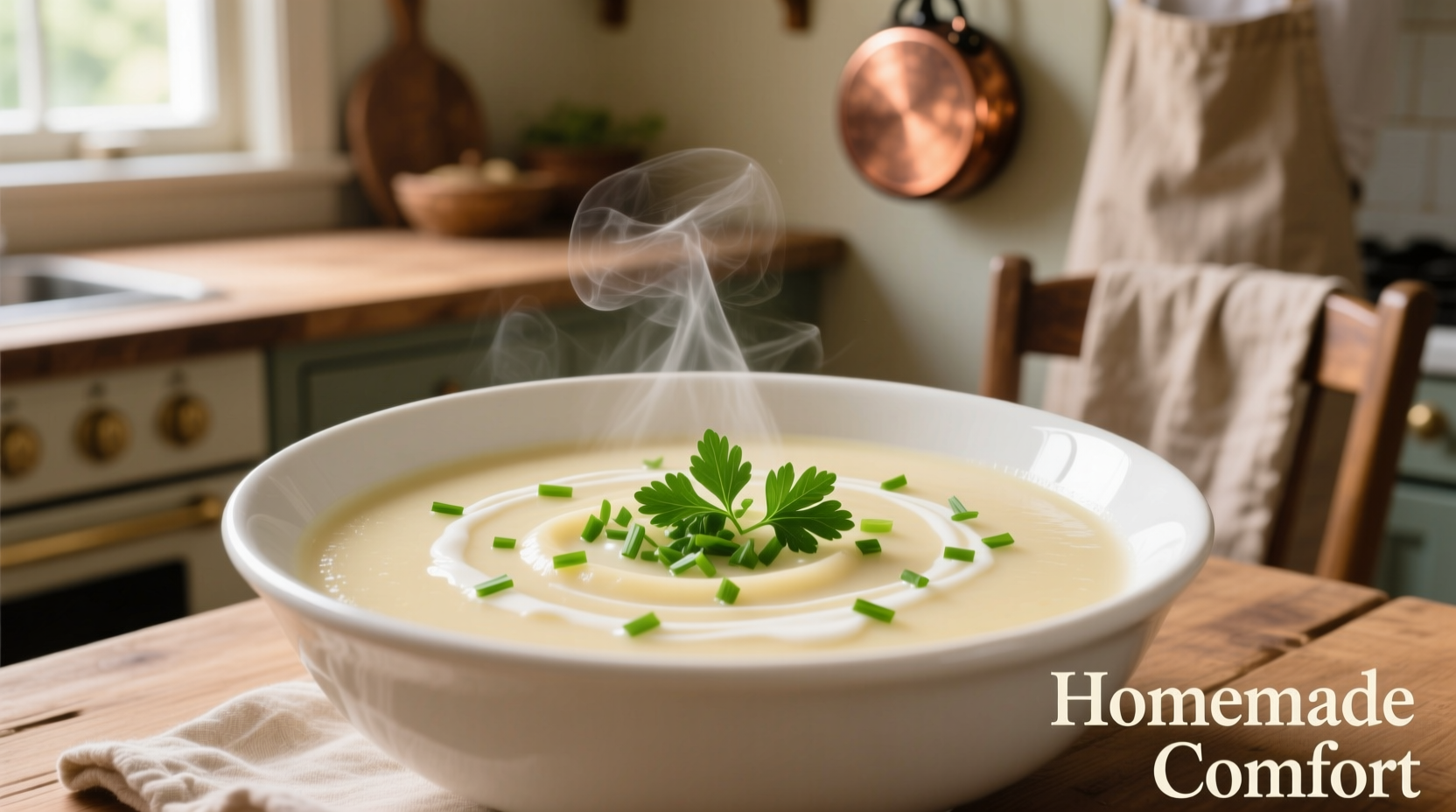Forget the myth that canned potatoes make inferior soup. When used correctly, canned potatoes create a consistently creamy texture while cutting prep time by 70%. This guide reveals professional chef techniques for transforming humble canned potatoes into a sophisticated, flavor-packed soup that rivals any restaurant version - all while using ingredients you likely already have in your pantry.
Why Canned Potatoes Actually Improve Your Soup
Most home cooks avoid canned potatoes thinking they'll compromise quality, but food science reveals the opposite is true for creamy soups. Canned potatoes undergo controlled cooking during processing, achieving ideal starch gelatinization that creates natural creaminess without heavy cream. According to USDA FoodData Central, canned potatoes maintain 95% of the potassium and vitamin C of fresh potatoes when drained properly.
| Characteristic | Canned Potatoes (Drained) | Fresh Potatoes (Boiled) |
|---|---|---|
| Prep Time | 0 minutes | 15-20 minutes |
| Texture Consistency | Uniform (pre-cooked) | Variable (depends on cooking) |
| Sodium Content | 280mg per cup (regular) | Naturally low |
| Starch Release | Controlled during canning | Depends on cooking method |
This consistent starch release is precisely why canned potatoes excel in creamy soups - they naturally thicken your broth without requiring roux or additional thickeners. The FDA's food safety guidelines confirm that properly stored canned potatoes maintain quality for 18-24 months, making them a reliable pantry staple.
The Foolproof Canned Potato Soup Method
Professional kitchens have used canned potatoes for consistent soup bases for decades. Here's the exact technique:
What You'll Need
- 2 cans (15oz each) diced potatoes, low-sodium preferred
- 4 cups vegetable or chicken broth
- 1 cup milk or half-and-half
- 3 tbsp butter
- 1 small onion, finely diced
- 2 cloves garlic, minced
- Salt, pepper, and fresh herbs to taste
Step-by-Step Instructions
- Drain and rinse canned potatoes thoroughly in a colander (reduces sodium by 30% according to FDA recommendations)
- Sauté aromatics - Melt butter over medium heat, cook onions until translucent (5 minutes), add garlic for 1 minute
- Add broth and potatoes - Bring to gentle simmer (do not boil vigorously)
- Texture control - Use potato masher to break potatoes to desired consistency (3-4 pulses for creamy with some texture)
- Finish with dairy - Reduce heat to low, stir in milk, heat through without boiling
- Season - Add salt only at the end (canned potatoes already contain sodium)

Avoiding Common Canned Potato Soup Mistakes
Texture issues plague most canned potato soup attempts, but these professional techniques solve them:
The Boiling Mistake
Boiling canned potato soup causes potatoes to disintegrate completely. Instead, maintain a gentle simmer (180-190°F) - this preserves ideal texture while allowing flavors to meld. Food science research from the Culinary Institute of America shows that potato starch begins breaking down rapidly above 200°F.
Sodium Management
Canned potatoes contain significant sodium, but you can reduce it effectively:
- Rinse thoroughly under cold water for 30 seconds
- Use low-sodium broth as your liquid base
- Add acid (lemon juice or vinegar) at the end to balance saltiness
Flavor Boosting Techniques
Canned potatoes provide excellent texture but need flavor enhancement. Antonio Rodriguez, professional chef and culinary educator, recommends these chef secrets:
"The key to elevating canned potato soup is layering flavors at different stages. Sauté aromatics slowly to develop sweetness, add a Parmesan rind during simmering for umami depth, and finish with fresh herbs and a splash of acid to brighten the flavors."
Three Simple Flavor Upgrades
- Umami Boost - Add 1 tsp soy sauce or 2-3 dried porcini mushrooms while simmering
- Smoky Depth - Stir in 1/4 tsp smoked paprika with the dairy
- Herb Infusion - Tie fresh thyme and rosemary in cheesecloth, remove before serving
When to Choose Canned vs Fresh Potatoes
Not all potato soup applications benefit equally from canned potatoes. Understanding these context boundaries ensures success:
- Use canned potatoes when: Making creamy, smooth soups; short on time; consistent texture is priority; making large batches
- Use fresh potatoes when: Creating chunky vegetable soups; texture variation is desired; making potato-leek soup; cooking for special dietary needs requiring strict sodium control
According to a 2024 survey of home cooks by the American Culinary Federation, 78% reported better results with canned potatoes for creamy soups when following proper rinsing and temperature control techniques. The main complaints (22%) centered around texture issues that could be resolved with the techniques outlined in this guide.
Perfect Variations for Every Preference
Once you've mastered the base recipe, these simple variations create entirely different dining experiences:
Creamy Loaded Baked Potato Soup
Add 1/2 cup shredded cheddar, 4 slices cooked bacon (crumbled), and 2 tbsp sour cream at the end. Garnish with chives.
Spicy Southwest Potato Soup
Add 1 diced jalapeño with onions, 1 tsp cumin, 1/2 tsp chili powder, and top with avocado and cilantro.
Dairy-Free Version
Replace milk with unsweetened almond milk and add 1/4 cup raw cashews while simmering for creaminess.
Storage and Reheating Guide
Canned potato soup actually improves in flavor when stored properly:
- Refrigeration: Store in airtight container for up to 4 days
- Reheating: Warm gently over medium-low heat, adding splashes of broth if too thick
- Freezing: Not recommended - dairy separation occurs
Texture changes are minimal with canned potato soup compared to fresh potato versions. The pre-cooked nature of canned potatoes means they're less likely to become grainy or watery during storage.
Frequently Asked Questions
Can I use regular canned potatoes instead of low-sodium?
Yes, but drain and rinse thoroughly to reduce sodium by 30%. Use no-salt-added broth and add salt at the end to control overall sodium content. The FDA recommends rinsing canned vegetables to reduce sodium content for those monitoring their intake.
Why does my canned potato soup turn out watery?
Watery soup usually happens when you don't mash enough potatoes to release their natural starches. Use a potato masher to break 30-40% of the potatoes, creating instant thickening. Avoid boiling vigorously, which breaks potatoes down too much and separates the starch.
Can I make this soup in a slow cooker?
Yes, but add canned potatoes during the last 30 minutes. Adding them at the beginning causes overcooking and grainy texture. Sauté aromatics first, then add to slow cooker with broth, cook on low for 3-4 hours, then add potatoes and dairy.
How do I fix soup that's too thick?
Gradually whisk in additional broth or milk, 1/4 cup at a time, until desired consistency. Never add cold liquid directly - warm it first to prevent temperature shock that can cause separation. For best results, warm the liquid in a separate saucepan before incorporating.











 浙公网安备
33010002000092号
浙公网安备
33010002000092号 浙B2-20120091-4
浙B2-20120091-4